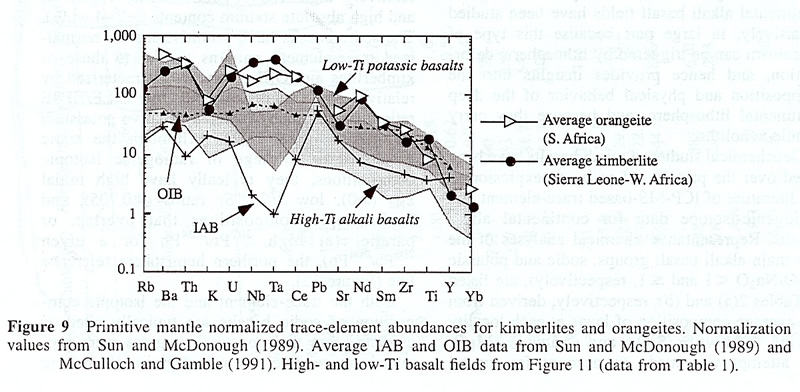
“Spider Diagram” for REE of common igneous rocks (from Farmer, 2003)
(just the basics)
Incompatible elements are those that prefer to be in the liquid phase rather than the solid phase of a melt. Over time, and with partial melting of the mantle, continental and oceanic crusts become enriched in the incompatible elements relative to the mantle melt residual. Incompatible elements include Rb, Sr, Nd, and light rare earth elements (LREE) in general.
REE Patterns

“Spider Diagram” for REE of common igneous rocks (from Farmer, 2003)
Igneous rocks produced as the result of different processes can have a wide range of isotopic signatures. “Spider Diagrams” for rare earth elements (REE) represent one type of tool used by geochemists to define deviations in REE concentrations of a “melt” versus the REE concentrations of some standard, generally “primitive mantle.” In subduction zones, for example, the affinity of Ta, Ti, and Nb to rutile in the downgoing slab produces melt compositions reflecting the reduced amounts of these rare earth elements in the fluids driven off the slab during dehydration. Similarly, K and Pb become mobile in the fluids driven off during slab dehydration and are carried up with the fluids, resulting in a melt enriched in K and Pb relative to other REE.
The Sm/Nd system and εNd Notation
Neodymium is less compatible in the mantle than its radiogenic parent, 147Sm. Therefore, Nd contents of melts are enriched in Nd relative to Sm. The residual is then enriched in Sm, which continues to produce 143Nd at a faster rate than the melt. Consequently, 143Nd/144Nd ratios in the residual mantle increase at a faster rate than that of the melt. The epsilon Nd notation was created using 143Nd/144Nd ratios relative to the 143Nd/144Nd ratios of a standard, like the “primitive mantle.”
εNd = [(143Nd/144Ndsample)/( 143Nd/144Ndstd)-1]*10,000
Using this system and notation provides a quick glimpse into possible melt sources. Very low, negative εNd values are generally found in continental crusts where the Nd system has been separated from the Sm “enriched” mantle for millions of years, whereas positive εNd values are commonly found in mantle derived melts, such as those of OIB and MORB rocks. Igneous rocks can acquire a wide range of εNd values depending on the processes under which they are formed, and the types of rocks they interacted with prior to eruption.
Rb/Sr and eSr
Like the Sm/Nd system, Rb and Sr relative abundances provide insight as to where magmas were generated. Rb is more compatible in the melt phase than is its parent, 87Sr, which gets left behind in the residual phase. Similar to Nd, Sr also has an epsilon notation. However, because the “compatible” component is Sr, the expected epsilon values for Sr are opposite those expected for Nd, where positive εSr are found in continental crusts, and negative εSr typically represent mantle sources.
More detailed information on these isotopic systems can be found on the 5700 website contributions from Eric Cannon, Joya Tetreault, and Tanya Unger.